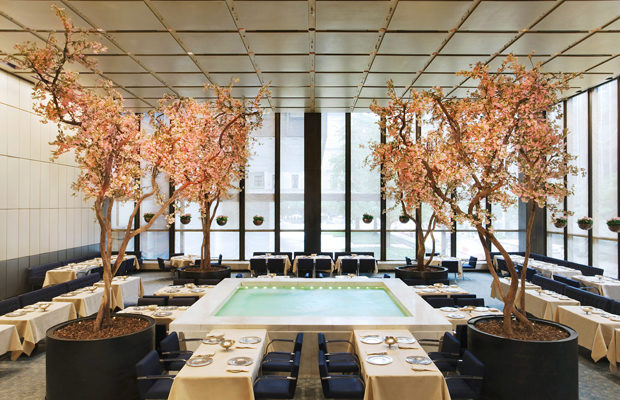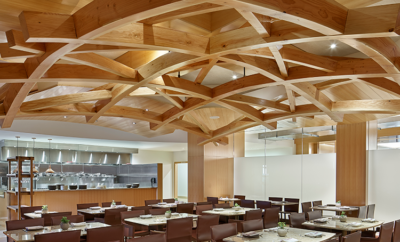 Inside The Four Seasons Pool Room. Photo courtesy of Jennifer Calais Smith.
Inside The Four Seasons Pool Room. Photo courtesy of Jennifer Calais Smith.
Feature
Taking Apart a Bastion of Modernism
Inside the Seagram Building, The Four Seasons’ patrons anxiously anticipate the restaurant’s final days, when its iconic décor will be dismantled and sold at auction.
The Wright auction house will hold this controversial sale on July 26th, when it plans to sell off most of The Four Seasons’ furnishings and tableware. Some of the prized pieces include Philip Johnson banquettes, chairs by Ludwig Mies van der Rohe, and the sleekly elegant dishware from industrial designer L. Garth and his wife, architecture critic Ada Louise Huxtable (a unique collaboration from the couple worth preserving in itself). The sale estimates currently range from $300 to $500 for the smaller tableware pieces up to $5,000 or $7,000 for the banquettes and bar stools.
Not all items will be auctioned off, however. The restaurant’s more permanent features, like the beaded curtains, iconic bar, Richard Lippold sculptures, and wooden wall paneling are protected by its landmark status (designated by the Landmarks Preservation Commission in 1989) and cannot be sold. Other items are also being withheld from the auction by Wright, such as the cracked glass screen in the bar area, because they are deemed too “essential to the design of the space.”
Even so, many design critics agree that the furnishings being sold work uniquely in tandem with the interior, and their removal will have a grave effect on the overall aesthetic of the restaurant. “The owners have pointed out that a restaurant is not a museum, but maybe it should have been a living monument to a certain kind of experience,” Aaron Betsky, former director of the Cincinnati Art Museum and dean of the Frank Lloyd Wright School of Architecture, told Dezeen. “Ironically, I am not sure how important or interesting the furnishings are outside of their relationship to each other.”
The Four Seasons owners, Alex von Bidder and Julian Niccolini, ultimately decided to hold this auction after Aby Rosen, the Seagram Building’s owner, refused to renew the restaurant’s lease so he could bring a more financially lucrative restaurant into the space.
Many are disappointed that the restaurant’s complete design will be taken apart, including architect and critic, Phyllis Lambert, who initially convinced her father, then the head of the Seagram Corporation, to hire Mies van der Rohe and Philip Johnson to design the company’s headquarters. Now, she has written an open letter to Rosen, imploring him to keep the restaurant as it is.
“My plea is to keep in place the furniture designed by Mies van der Rohe and Philip Johnson, and therefore to maintain the authenticity of two of the world’s greatest rooms.”
The Four Seasons is just one of many iconic modernist restaurants in New York that have recently shut down. Others include Alexander Girard’s 1960 La Fonda del Sol in the Time & Life Building and his 1966 L’Etoile at the Sherry Netherlands Hotel, and Roche Dinkeloo’s Ambassador Grill.
“For decades, The Four Seasons restaurant has been a space that provided one of the rarest phenomena in Modernism: a place where the architecture, the furniture, the table settings, the service, the food, and even the clientele was of a piece,” Betsky told Dezeen.
By the end of the month, this will no longer hold true.

Corner banquette from The Four Seasons by Philip Johnson. Auction sale estimate: $2000-3000. Photo courtesy of Wright.












